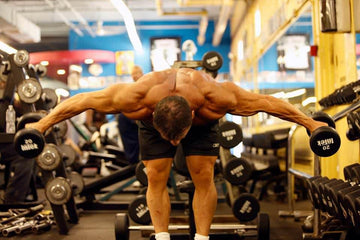

Shorter, Multiple Bouts of Exercise Better for Fat Loss
Table of Contents
Shorter, Multiple Bouts of Exercise Better for Fat Loss
by: Robbie Durand
Dieting is often perceived as the fastest and most accessible solution not only for quick weight loss but also for long-term weight maintenance.
The fear of losing muscle is a common phenomenon among bodybuilders, fitness models and recreational lifters. The dieting athlete is like a fiddler on the roof, he must walk a fine line between diet and exercise, because too much of anything will cause a person to topple into the abyss.
A diet that’s too restrictive and eliminates too many foods or groups of food is very likely to contribute to the weakening of bones and to muscle loss. An excellent review paper titles, “Changes in Fat-Free Mass During Significant Weight Loss: A Systemic Review.” is a must read for the science buffs out there who want to look at all the studies. This medical review examined 16 medical and 17 surgical weight-loss studies. The analysis of these studies indicates that very-low-calorie diets provide rapid weight-loss, but also contribute to a substantial loss in fat-free mass (basically everything in your body that isn’t fat). Loss of muscle mass was positively correlated with increased levels of caloric restriction and exercise.
According to new research, if your training is intense enough and combines a combination of resistance exercise and cardio, you can drop bodyfat without even dieting.
According to a new study, already lean male & female taekwondo athletes shed 10% ot their bodyfat in 8 Weeks with AM, PM, & Evening Training. Basically, the athletes lived at the gym and trained three times a day!! Talk about being dedicated…They trained with high and low intensity exercise everyday.
 The purpose of the study was to determine the effect of 8 weeks pre-season training on body composition, physical fitness, anaerobic capacity, and strength in collegiate taekwondo athletes. Thirty-four collegiate athletes (male: 22, female: 12) participated. Body com position, bone mineral density, physical fitness, anaerobic capacity, and isokinetic muscle strength were tested.
The purpose of the study was to determine the effect of 8 weeks pre-season training on body composition, physical fitness, anaerobic capacity, and strength in collegiate taekwondo athletes. Thirty-four collegiate athletes (male: 22, female: 12) participated. Body com position, bone mineral density, physical fitness, anaerobic capacity, and isokinetic muscle strength were tested.
The training program included high-in tensity continuous running and stair climbing in the morning, low-intensity continuous running and circuit training in the afternoon, and a program of sit-ups and push-ups in the evening. High-intensity continuous running was conducted at 85-90% of HRmax, and long, slow distance running at 60-80% of HRmax. Circuit training and was conducted at 40-60% intensity, of 20 repetitions each section. The sit-up and push-up program consisted of 3 sets of 40 repetitions.
To monitor the work intensity during each training session, a heart rate monitor was used. The Circuit training protocol was “① Chest-press, ② Biceps-curl, ③ Triceps extension, ④ Seated dip, ⑤ Shoulder press, ⑥ Real delt, ⑦ Switch foot box drill with barbell, ⑧ Squat barbell-jump, ⑨ Jerk, ⑩ Power clean, ⑪ Leg press, ⑫ Leg extension. Sit-up & Push-up program: ① V-up, ② Push-up, ③ Scissors kick, ④ Diamond Push-up, ⑤ Back extension, ⑥ Wide hands Push-up, ⑦ V-up combination”
After statistical analysis was performed the results indicated that there were significant decreases in body weight, percent body fat, and fat tissue after 8 weeks of pre-season training without dieting. Bone mineral density increased significantly only in males. There were significant improvements in the 50 m shuttle run and 20 m multistage endurance run in both males and females. Relative peak power and anaerobic capacity were significantly improved in males.
Neither men nor women lost significant amounts of lean mass (also because they didn’t diet), and improved their 50 m shuttle run and 20 m multistage endurance run performance by ~5% and ~10%, respectively.
In conclusion, this study suggests that 8 weeks of pre-season training has a positive effect on body composition, physical fitness, anaerobic capacity, muscular strength, and endurance. Nevertheless, an exercise approach with the goal of increasing lean tissue, and improving power in knee flexors and flexibility of athletes, should be included in the training program.
If you have the time, you may want to ramp up to two a day protocol like the study did and have intense training sessions in the morning followed by a low intensity training protocol in the evening.
Seo, Myong-Won, et al. “Effect of 8 weeks of pre-season training on body composition, physical fitness, anaerobic capacity, and isokinetic muscle strength in male and female collegiate taekwondo athletes.” Journal of Exercise Rehabilitation 11.2 (2015): 101-107.


















